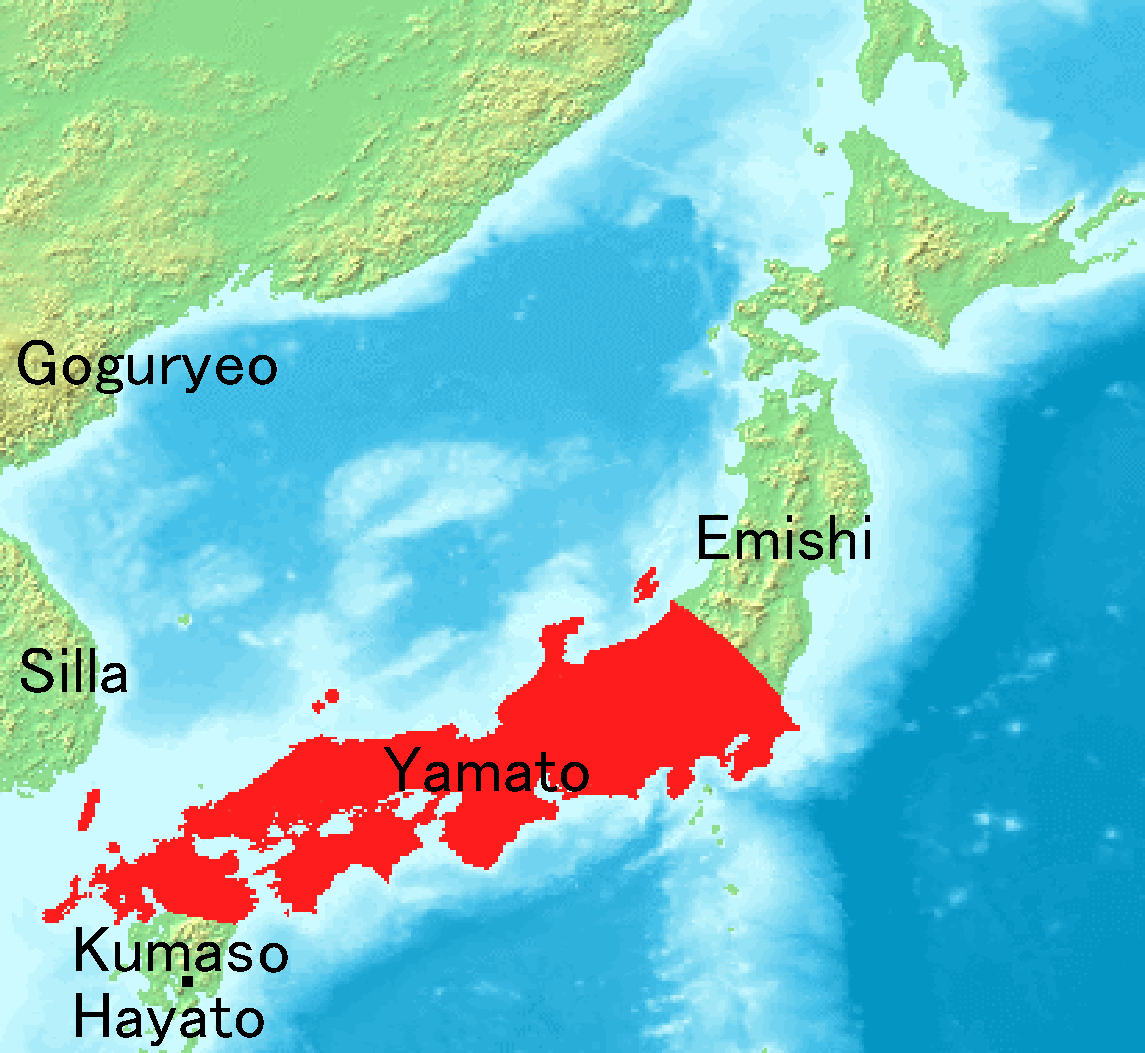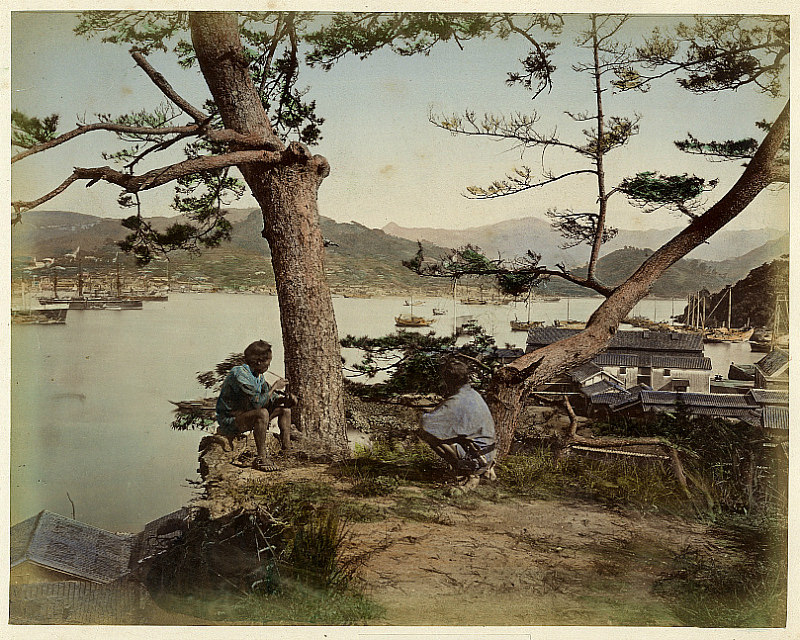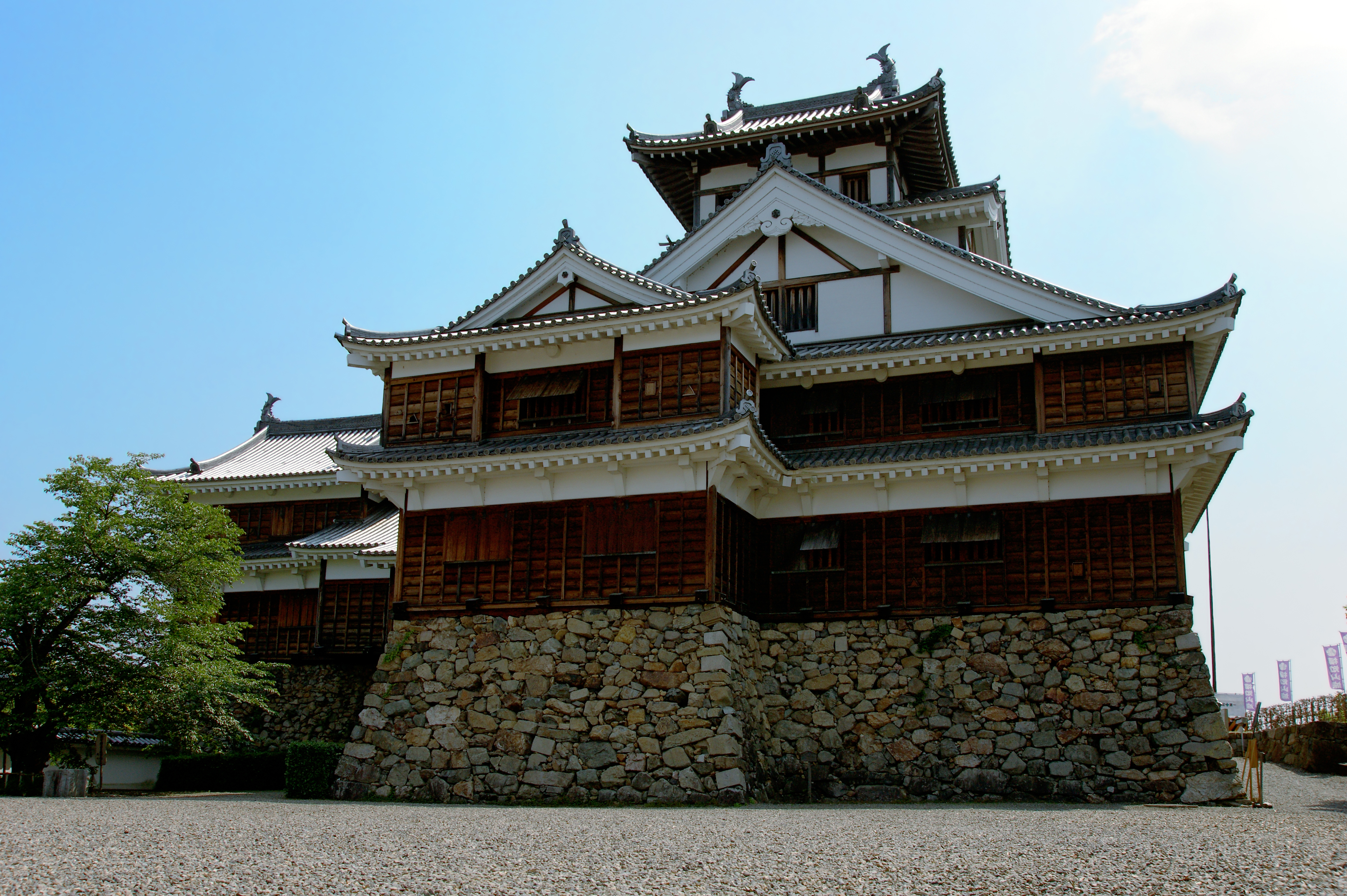|
Kaneda Castle
was a Korean-style fortress located in Tsushima, Nagasaki prefecture. Kaneda castle has been designated as being of national special significance. History Kaneda Castle was built by Yamato court. Following the defeat of Yamato Japan in the 663 battle of Hakusukinoe by an alliance of Tang China and the Silla, Emperor Tenji ordered the construction of defenses against a possible invasion of them. The castle was listed as one of the Continued Top 100 Japanese Castles in 2017. Shrine It contains a shrine in it which is a See also * List of Historic Sites of Japan (Nagasaki) *List of foreign-style castles in Japan This is a list of foreign-style castles in Japan. In Japan, the word ' 城(''shiro'') has broader meanings than western world, so this list includes the buildings near to fortresses. Korean style castles Chinese style castle Portuguese st ... Literature * References External links Kaneda castle, Tsushima city official Castles in Nagasaki Prefe ... [...More Info...] [...Related Items...] OR: [Wikipedia] [Google] [Baidu] |
Tsushima, Nagasaki
is an island city grouped in Nagasaki Prefecture, Japan. It is the only city of Tsushima Subprefecture and it encompasses all of Tsushima Island Archipelago, which lies in the Tsushima Strait north of Nagasaki on the western side of Kyushu, the southernmost mainland island of Japan. As of March 2017, the city has an estimated population of 31,550 and a population density of 45 persons per km2. Its total area is 708.61 km2, 17.3% of the area of Nagasaki Prefecture. History An Imperial decree in July 1899 established Izuhara, Sasuna, and Shishimi as open ports for trading with the United States and the United Kingdom. On April 1, 1975, Toyotama Village was promoted to the status of a town. Mine Village was also elevated to the status of a town in the following year. The modern city of Tsushima was established on March 1, 2004, from the merger of six towns on Tsushima Island: Izuhara, Mitsushima, and Toyotama (all from Shimoagata District), and Mine, Kamiagata, and Kamits ... [...More Info...] [...Related Items...] OR: [Wikipedia] [Google] [Baidu] |
Korean-style Fortresses In Japan
Over the course of the Yamato period, in the early centuries of the establishment of a Japanese state, a great number of Korean-style fortresses (朝鮮式山城, ''Chōsen-shiki yamajiro'') were constructed in Japan. Old fortresses dating to the 8th century and earlier can be found all over western Japan. Many of these sites have been identified with fortresses whose construction, repair, and destruction are described in detail in ancient chronicles such as '' Nihon Shoki'' and ''Shoku Nihongi''. According to some interpretations of these texts, these fortresses were built under the guidance of, and at the orders of, various members of the Korean nobility or royalty. Comparisons of these sites have been made to other Japanese fortresses, and to sites of the same period in both Korea and China. The theory persists of direct Korean involvement in the construction of these fortresses and threat of invasion by the Korean Silla dynasty and Chinese Tang Dynasty incited the Yamato co ... [...More Info...] [...Related Items...] OR: [Wikipedia] [Google] [Baidu] |
Yamato Period
The is the period of Japanese history when the Imperial court ruled from modern-day Nara Prefecture, then known as Yamato Province. While conventionally assigned to the period 250–710, including both the Kofun period (–538) and the Asuka period (538–710), the actual start of Yamato rule is disputed. The Yamato court's supremacy was challenged during the Kofun period by other polities centered in various parts of Japan. What is certain is that Yamato clans had major advantages over their neighbouring clans in the 6th century. This period is divided by the relocation of the capital to Asuka, in modern Nara Prefecture. However, the Kofun period is an archaeological period while the Asuka period is a historical period. Therefore, many think of this as an old division and this concept of period division is no longer applicable. At the era of Prince Shōtoku in the early 7th century, a new constitution was prescribed for Japan based on the Chinese model. After the fall of ... [...More Info...] [...Related Items...] OR: [Wikipedia] [Google] [Baidu] |
Nagasaki Prefecture
is a prefecture of Japan located on the island of Kyūshū. Nagasaki Prefecture has a population of 1,314,078 (1 June 2020) and has a geographic area of 4,130 km2 (1,594 sq mi). Nagasaki Prefecture borders Saga Prefecture to the northeast. Nagasaki is the capital and largest city of Nagasaki Prefecture, with other major cities including Sasebo, Isahaya, and Ōmura. Nagasaki Prefecture is located in western Kyūshū with a territory consisting of many mainland peninsulas centered around Ōmura Bay, as well as islands and archipelagos including Tsushima and Iki in the Korea Strait and the Gotō Islands in the East China Sea. Nagasaki Prefecture is known for its century-long trading history with the Europeans and as the sole place of direct trade and exchange between Japan and the outside world during the ''Sakoku'' period. Nagasaki Prefecture is home to several of the Hidden Christian Sites in the Nagasaki Region which have been declared a UNESCO World Heritage Site. ... [...More Info...] [...Related Items...] OR: [Wikipedia] [Google] [Baidu] |
Battle Of Hakusukinoe
The Battle of Baekgang or Battle of Baekgang-gu, also known as Battle of Hakusukinoe ( ja, 白村江の戦い, Hakusuki-no-e no Tatakai / Hakusonkō no Tatakai) in Japan, as Battle of Baijiangkou ( zh, c=白江口之战, p=Bāijiāngkǒu Zhīzhàn, t=白江口之戰) in China, was a battle between Baekje restoration forces and their ally, Yamato Japan, against the allied forces of Silla and Tang China. The battle took place in the Baengma River () or Baek River (), which is the lower reach of the Geum River in Jeollabuk-do province, Korea. The Silla-Tang forces won a decisive victory, compelling Yamato Japan to withdraw completely from Korean affairs and crushing the Baekje restoration movement. Background In the first half of the first millennium CE, the Korean Peninsula was divided into three kingdoms – Baekje, Silla, and Goguryeo. Despite sharing similar cultures and using mutually-intelligible languages (while the language of Silla is described in modern-day scholarshi ... [...More Info...] [...Related Items...] OR: [Wikipedia] [Google] [Baidu] |
Tang China
The Tang dynasty (, ; zh, t= ), or Tang Empire, was an imperial dynasty of China that ruled from 618 to 907 AD, with an interregnum between 690 and 705. It was preceded by the Sui dynasty and followed by the Five Dynasties and Ten Kingdoms period. Historians generally regard the Tang as a high point in Chinese civilization, and a golden age of cosmopolitan culture. Tang territory, acquired through the military campaigns of its early rulers, rivaled that of the Han dynasty. The Lǐ family () founded the dynasty, seizing power during the decline and collapse of the Sui Empire and inaugurating a period of progress and stability in the first half of the dynasty's rule. The dynasty was formally interrupted during 690–705 when Empress Wu Zetian seized the throne, proclaiming the Wu Zhou dynasty and becoming the only legitimate Chinese empress regnant. The devastating An Lushan Rebellion (755–763) shook the nation and led to the decline of central authority in the dynast ... [...More Info...] [...Related Items...] OR: [Wikipedia] [Google] [Baidu] |
Silla
Silla or Shilla (57 BCE – 935 CE) ( , Old Korean: Syera, Old Japanese: Siraki2) was a Korean kingdom located on the southern and central parts of the Korean Peninsula. Silla, along with Baekje and Goguryeo, formed the Three Kingdoms of Korea. Founded by Hyeokgeose of Silla, of the Park family, the Koreans, Korean dynasty was ruled by the Kim (Korean surname)#Gyeongju, Gyeongju Gim (Kim) (김, 金) clan for 586 years, the Park (Korean surname)#Miryang, Miryang Bak (Park) (박, 朴) clan for 232 years and the Seok (Korean surname)#Wolseong, Wolseong Seok (석, 昔) clan for 172 years. It began as a chiefdom in the Samhan confederacies, once allied with Sui dynasty, Sui China and then Tang dynasty, Tang China, until it eventually conquered the other two kingdoms, Baekje in 660 and Goguryeo in 668. Thereafter, Unified Silla occupied most of the Korean Peninsula, while the northern part re-emerged as Balhae, a successor-state of Goguryeo. After nearly 1,000 years of rule, ... [...More Info...] [...Related Items...] OR: [Wikipedia] [Google] [Baidu] |
Emperor Tenji
, also known as Emperor Tenchi, was the 38th emperor of Japan, Imperial Household Agency (''Kunaichō'')天智天皇 (38)/ref> according to the traditional order of succession.Ponsonby-Fane, Richard. (1959). ''The Imperial House of Japan'', p. 52. Tenji's reign spanned the years from 661 through 672.Titsingh, Isaac. (1834). Traditional narrative He was the son of Emperor Jomei, but was preceded as ruler by his mother Empress Saimei. Prior to his accession, he was known as . Events of Tenji's life As prince, Naka no Ōe played a crucial role in ending the near-total control the Soga clan had over the imperial family. In 644, seeing the Soga continue to gain power, he conspired with Nakatomi no Kamatari and Soga no Kurayamada no Ishikawa no Maro to assassinate Soga no Iruka in what has come to be known as the Isshi Incident. Although the assassination did not go exactly as planned, Iruka was killed, and his father and predecessor, Soga no Emishi, committed suicide soon ... [...More Info...] [...Related Items...] OR: [Wikipedia] [Google] [Baidu] |
Continued Top 100 Japanese Castles
The is a list of 100 castles, intended as a sequel of 100 Fine Castles of Japan The castles in were chosen based on their significance in culture, history, and in their regions by the in 2006. In 2017, Japanese Castle Association created an additional finest 100 castles list as Continued Top 100 Japanese Castles. Hokkaidō .... The castles were chosen for their significance in culture, history, and in their regions by the in 2017. Hokkaidō region Tōhoku region Kantō region Kōshin'etsu region Hokuriku region Tōkai region Kansai region Chūgoku region Shikoku region Kyūshū region Okinawa region See also * List of castles in Japan * List of National Treasures of Japan (castles) Notes External linksJapan Castle Foundation {{Continued Top 100 Japanese Castles * Lists of castles in Japan ... [...More Info...] [...Related Items...] OR: [Wikipedia] [Google] [Baidu] |
List Of Historic Sites Of Japan (Nagasaki)
This list is of the Historic Sites of Japan located within the Prefecture of Nagasaki. National Historic Sites As of 1 July 2019, thirty-two Sites have been designated as being of national significance (including two *Special Historic Sites). Prefectural Historic Sites As of 1 May 2019, ninety-three Sites have been designated as being of prefectural importance. Municipal Historic Sites As of 1 May 2018, a further three hundred and nineteen Sites have been designated as being of municipal importance. See also * Cultural Properties of Japan * Hizen Province * Tsushima Province * Iki Province * List of Places of Scenic Beauty of Japan (Nagasaki) * List of Cultural Properties of Japan - paintings (Nagasaki) * Nagasaki Museum of History and Culture The in Nagasaki, Japan is one of the few museums in Japan devoted to the theme of "overseas exchange". The museum holds 48,000 items in its collection, including historical documents and arts and crafts, that tell the ... [...More Info...] [...Related Items...] OR: [Wikipedia] [Google] [Baidu] |
List Of Foreign-style Castles In Japan
This is a list of foreign-style castles in Japan. In Japan, the word ' 城(''shiro'') has broader meanings than western world, so this list includes the buildings near to fortresses. Korean style castles Chinese style castle Portuguese style castle French style castles French style bastion fort Japanese castles with French-style buildings * Other Japanese castles stationed by French style Japanese troops includes Sakura Castle, Utsunomiya Castle, Takasaki Castle, Sendai Castle, Kanazawa Castle, Osaka Castle, Himeji Castle, Hiroshima Castle, Marugame Castle, Kumamoto Castle, Kokura Castle, and Fukuoka Castle. 森山英一,2019年10月22日アクセス, p.113 English style cast ...
|
Castles In Nagasaki Prefecture
A castle is a type of fortified structure built during the Middle Ages predominantly by the nobility or royalty and by military orders. Scholars debate the scope of the word ''castle'', but usually consider it to be the private fortified residence of a lord or noble. This is distinct from a palace, which is not fortified; from a fortress, which was not always a residence for royalty or nobility; from a ''pleasance'' which was a walled-in residence for nobility, but not adequately fortified; and from a fortified settlement, which was a public defence – though there are many similarities among these types of construction. Use of the term has varied over time and has also been applied to structures such as hill forts and 19th-20th century homes built to resemble castles. Over the approximately 900 years when genuine castles were built, they took on a great many forms with many different features, although some, such as curtain walls, arrowslits, and portcullises, were ... [...More Info...] [...Related Items...] OR: [Wikipedia] [Google] [Baidu] |




-by-Utagawa-Kuniyoshi.png)



